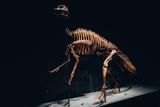Science
New Study Unveils Unique Mummified Dinosaur Hooves and Features

A recent study has revealed remarkable insights into the anatomy and preservation of the dinosaur Edmontosaurus annectens, known for its horse-like hooves and duck-like bill. These findings, published in the journal Science, detail how certain specimens have been preserved in a unique clay matrix, leading researchers to refer to them as “mummies.” The study focused on two specimens discovered in Wyoming, which were buried in an area termed the “mummy zone.”
Located in the western United States, Edmontosaurus annectens was part of a group of hadrosaurids, commonly called “duck-billed dinosaurs.” These creatures thrived just before the Cretaceous-Paleogene extinction event approximately 66 million years ago. Fossil remains of these dinosaurs are found in various states including Wyoming and Colorado, as well as in the Canadian provinces of Saskatchewan and Alberta.
Uncovering Dinosaur Mummies in Wyoming
The two distinct E. annectens specimens, a juvenile approximately 2 years old and an early adult aged between 5 and 8 years, captured the attention of paleontologists due to their exceptional preservation. Unlike typical dinosaur fossils, which often consist of bones or teeth, these specimens exhibit outlines of their bodies preserved in a thin layer of sediment.
The study found that these dinosaurs were likely engulfed by a flash flood, which subsequently deposited clay over their carcasses. While the organic material dissolved over time, a delicate clay film, measuring only 1/100th of an inch thick, formed a three-dimensional template of the dinosaurs.
“This is a mask, a template, a clay layer so thin you could blow it away,” explained Paul Sereno, a paleontologist at the University of Chicago. He emphasized the uniqueness of this preservation method, noting that it is a rare occurrence in paleontology.
Extraordinary Features and Significance
Using advanced imaging techniques such as micro-CT scans and X-ray spectroscopy, researchers documented several notable features of E. annectens. The dinosaur had a fleshy crest along its neck and trunk, transitioning into a row of spikes along its tail. Its scales were relatively small, measuring between 1 and 4 millimeters in diameter, with wrinkles on the ribcage suggesting thin skin.
Among the most astonishing discoveries were the dinosaur’s hooves. Through CT scans and comparisons with other known duck-billed dinosaur footprints, researchers reconstructed the hooves, revealing that each of the three hind toes was encased in a wedge-shaped hoof with a flat bottom. This feature is similar to that of modern horses.
Sereno highlighted the significance of these findings: “There are so many amazing ‘firsts’ preserved in these duck-billed mummies — the earliest hooves documented in a land vertebrate, the first confirmed hooved reptile, and the first hooved four-legged animal with different forelimb and hindlimb posture.”
The research not only enhances the understanding of Edmontosaurus anatomy but also sheds light on the preservation conditions that allowed these fossils to maintain their unique characteristics. As paleontologists continue to explore these findings, they provide an intriguing glimpse into the lives of dinosaurs that once roamed the Earth.
-

 Lifestyle5 months ago
Lifestyle5 months agoLibraries Challenge Rising E-Book Costs Amid Growing Demand
-

 Sports4 months ago
Sports4 months agoTyreek Hill Responds to Tua Tagovailoa’s Comments on Team Dynamics
-

 Sports4 months ago
Sports4 months agoLiverpool Secures Agreement to Sign Young Striker Will Wright
-

 Lifestyle4 months ago
Lifestyle4 months agoSave Your Split Tomatoes: Expert Tips for Gardeners
-

 Lifestyle4 months ago
Lifestyle4 months agoPrincess Beatrice’s Daughter Athena Joins Siblings at London Parade
-

 Science4 months ago
Science4 months agoSan Francisco Hosts Unique Contest to Identify “Performative Males”
-

 World4 months ago
World4 months agoWinter Storms Lash New South Wales with Snow, Flood Risks
-

 Science5 months ago
Science5 months agoTrump Administration Moves to Repeal Key Climate Regulation
-

 Business5 months ago
Business5 months agoSoFi Technologies Shares Slip 2% Following Insider Stock Sale
-

 Science5 months ago
Science5 months agoNew Tool Reveals Link Between Horse Coat Condition and Parasites
-

 Sports5 months ago
Sports5 months agoElon Musk Sculpture Travels From Utah to Yosemite National Park
-

 Science5 months ago
Science5 months agoNew Study Confirms Humans Transported Stonehenge Bluestones









